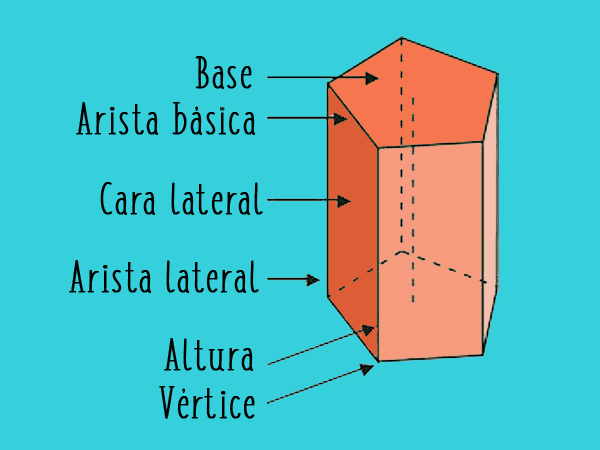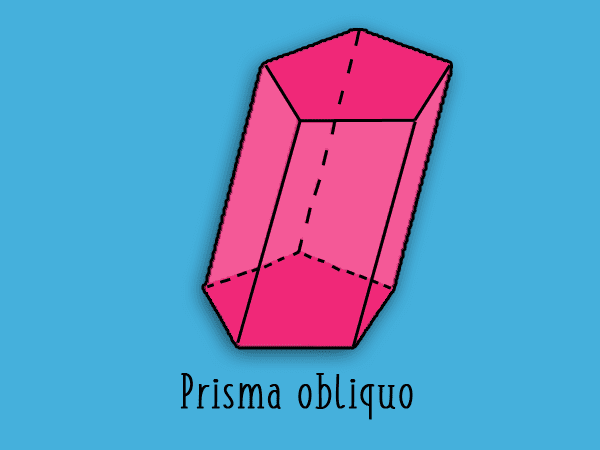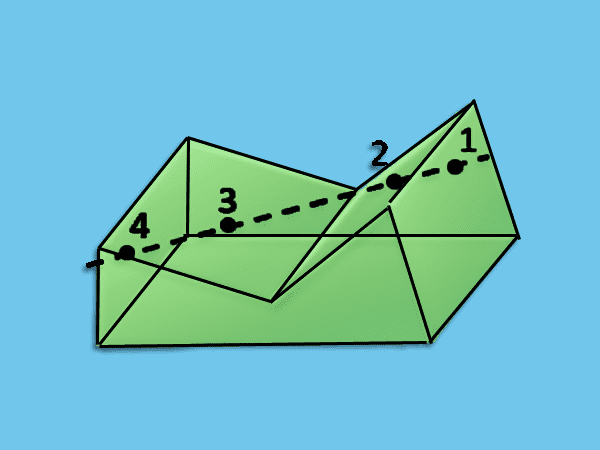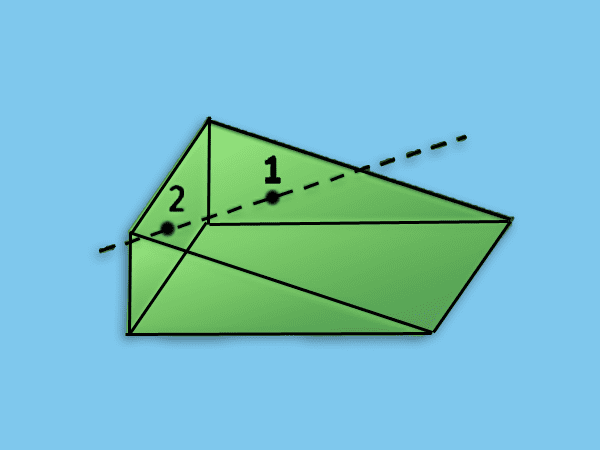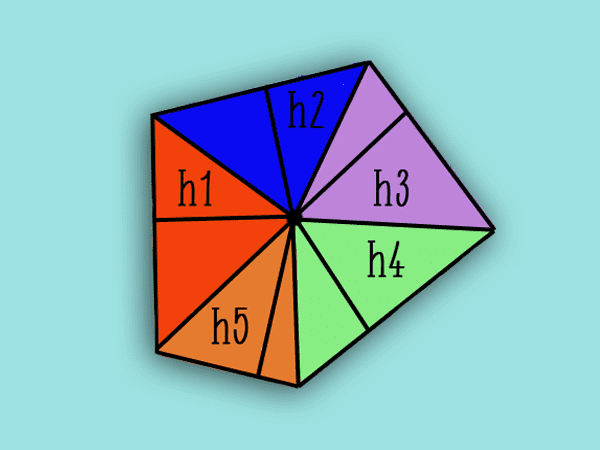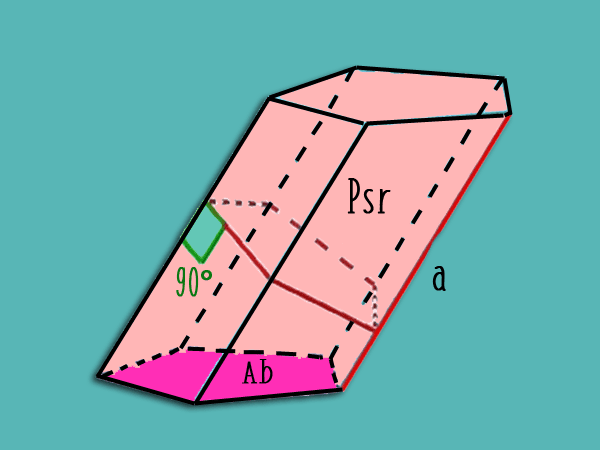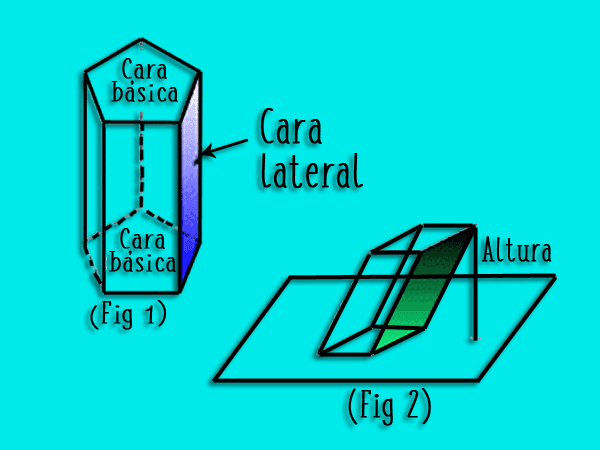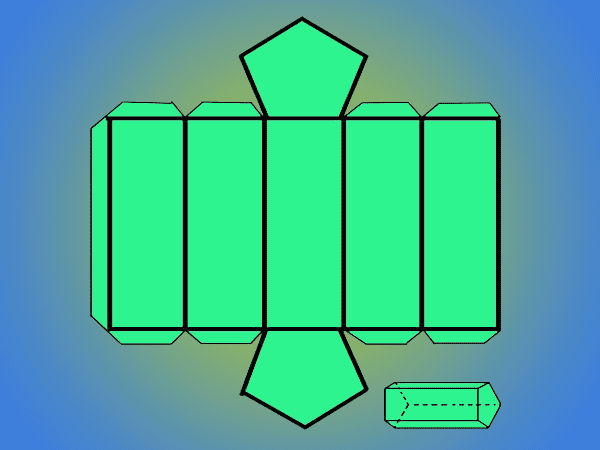It is a three-dimensional geometric figure that is composed of two equal parallel polygons as bases and lateral faces that are parallelograms. They receive a specific name according to the number of sides that form their base. Thus we have, for example, that if its bases have three sides it will be a triangular prism, four rectangular sides, five pentagonal sides, etc.
The topic at hand is specifically everything related to pentagonal prism, but it is necessary to know the common aspects of prisms in general.
General characteristics of a prism
Elements that make up a prism:
- Base They are two parallel and equal polygons that form the floor and the top of the prism. The number of its sides can be variable and they are precisely the ones that give the prism a first and last name.
- Side faces: are the parallelograms that separate the lower base from the upper one
- Height: It is the distance that is separating the two bases.
- Edges: Each one of the sides of the polygons that form the bases are called, edges of the base. And each of the sides of the lateral faces is called individually, lateral edge.
- Vertex: Each of the points where the edges meet is called a vertex.
Classification of prisms
A prism is classified according to the properties of its bases in:
- Regular:It is one whose base is a polygon that has all its sides of equal length and also its internal angles are of the same measure.
- Irregular: It is one whose bases are represented by polygons with different sides and internal angles.
According to the number of sides that their bases have, they are classified into:
- Triangular 3 sides
- Quadrangular 4 sides
- Pentagonal 5 sides
- Hex 6 sides
- Heptagonal 7 sides
- Octagonal 8 sides
- 9-sided eneagon or nonagon
- Decagon 10 sides ..., and so on.
According to their lateral faces they are classified into:
- Right prism: It is the one that has as many lateral faces as its base has, they are rectangular and parallel to it.
- Oblique: An oblique prism does not have perpendicularity on its lateral faces with respect to its base. Its lateral faces are rhomboid. Their particular characteristic is that their height does not coincide with the value of their lateral edges.
According to their internal angles they are classified into
Concaves: A prism can be classified as concave when its internal angles are greater than 180 °. Due to its irregular shape, which gives the vision of a slit towards the inside of the prism, if we cross it with a straight line it can be cut in more than one point.
Convex: A prism is convex when its internal angles measure less than 180 ° and on the other hand we have that when crossing it with a line it only cuts at two unique points.
Pentagonal prism
Now we are ready to learn more about the pentagonal prism. Once the characteristics common to every prism have been identified, we will delve specifically into the Pentagonal Prism. A pentagonal prism is one whose bases are equal and parallel pentagons and five parallelograms that form its lateral faces.
Features
The pentagonal prism has the following characteristics:
- Base. It has two parallel and equal pentagons.
- Faces. It has five lateral faces plus the two bases, in total there are seven faces,
- Height. It is the distance between the two bases.
- Vertex. They are the points of the prism where three of the faces coincide, in total there are 10 vertices.
- Edges. They are the meeting points of two of the faces of the prism, in total it has 15 edges.
According to Euler's Theorem, there is an interrelation between the number of faces (C), the edges (A) and the vertices of every prism whose internal angles measure less than 180 ° (convex).
Applying the formula A = C + V-2 the number of edges of a pentagonal prism can be found: A = 7 + 10-2 = 15
How Calculate the area of a regular pentagonal prism
It has its bases of regular pentagons and rectangular sides equal, so the calculation of its area is given by:
Area = 5. L. (ap. + H), where L is the measure of one of the sides of the pentagon, ap. (apothem) is the shortest distance from the center to either side and h is the height of the prism.
How to find the value of ap (apothem) of a pentagonal prism?
It is a variable that we do not know as obviously as the others. Well here is the mathematical formula to find it.
Knowing the number of sides (N) and their measure (L), first calculate the central angle that is formed between the center of the polygon and two consecutive vertices, like this:
? = 360 ° / N
Example: central angle of a pentagon? = 360 ° / 5 equals 72 °.
Next is the apothem
Dividing the measure of one of the sides (L) by twice the tangent of the half of the central angle (?)
ap = L / 2 x tang (? / 2)
Example: having a pentagonal prism whose sides have a measure of 20 cm and 30 centimeters in height, let's find its area. We already know that the value of the central angle of a regular pentagon is 72 °. Let's find its apothem:
Ap = 20/2 x Tang (72/2)
Ap = 20/2 x Tang (36)
Ap = 20/2 x (0.73)
Ap = 20 / 1.46
Ap = 13,69 cms.
Now yes, we have all the data to determine your area:
Area = 5 x L x (ap + h)
5 x 20 (13,69 + 30)
100 (43,69)
Area = 4369 cm.
Area of an irregular pentagonal prism
Taking into account that an irregular pentagonal prism has two irregular pentagons as its base, it is necessary to find the area of the irregular pentagon (Ab), its perimeter (Pb) and the height of the prism to later calculate the area of the prism.
The formula for the area of an irregular pentagonal right prism is:
Prism area = 2. Ab + Pb. h
The area of the base irregular pentagon (Ab) is found through the method of triangulation, which means dividing it into smaller triangular figures to calculate their areas and thus more easily the total area of the pentagon is obtained by adding all of them.
The perimeter of an irregular pentagon base (Pb) is found by adding the measure of its five sides.
Area of an oblique pentagonal prism
The area calculation formula for this type of prism is different from that of the right pentagonal prism.
The area of the bases is calculated in the same way as in the straight, the difference lies in the sides due to the fact that they are inclined.
The area of one of the sides of an oblique pentagonal prism is calculated based on the measurement of a lateral edge and the perimeter of the prism straight section.
The intersection of a plane with the prism at an angle of 90 ° with each of the lateral edges, is the straight section of the prism. That is, it is the flat base that is observed when dividing the prism transversely.
To find the graphical representation of the straight section of an oblique prism Anyone, place the square resting on one of its edges and, forming a 90 ° angle, draw a line that reaches the adjacent edge and so on with the other edges. Once this procedure is done, that surface can be visualized on the plane.
Area = 2. Ab + Psr. to
Where Ab is the area of the base, psr is the perimeter of the straight section of the prism and a a lateral edge.
To determine the value of the perimeter of the straight section, it is enough to square one of its edges at an angle of 90 °, measure the distance from that edge to where it intersects its parallel edge and add it five times.
Volume of a pentagonal prism
To calculate the volume of a pentagonal prism, both straight and oblique, the general formula for all types of prism is applied: multiply the area of the base (Ab) by the height measurement (h).
Volume = Ab. h
Substituting Ab by its own formula we have Volume = 5. L. ap / 2. h
Remember that in a right prism the height measurement is equal to the lateral edge measurement while in an oblique prism the height of the prism does not coincide with the measurement of the lateral edge, whatever the type of prism, be careful not to confuse.
How to make a straight regular pentagonal prism
? = 108 ° internal angle formed between two of the sides of the base pentagon (fixed measurement for a pentagonal figure)
L = side
H = height
Pentagonal base stroke
Before starting to draw the prism, its bases must be defined. In an easy and not so technical way I will explain how to make a regular pentagonal figure.
- draw a straight line that will serve as a starting point (fig. 1)
- mark the measurement you want to give to the sides of your pentagon, line (ab) Fig. 2
- With the help of a protractor, stopping at the point “a "And to the left look for the angle of 108 °, draw a line between" a "and the intersection with the angle found and on it mark the measure chosen for the sides of the pentagon. (line ac) fig. 3
- Lean on point b to the right do the same procedure as above and find the other side (line bd) fig. 4
- Then lean on point "c", always looking for an angle of 108 ° and draw the (ce line) fig.5
- Finally, join the ed points that make up the missing side. It should automatically have the angle of 108 °. Fig. 6
This geometric figure has more technical and precise forms for its stroke, but here I explain it to you in a simple way using only rulers and / or squares and a protractor.
The success of the construction of your prism will depend on the accuracy of the tracing of its bases.
And the accuracy in the construction of your pentagonal base will depend on your skill and knowledge of the measurement tools that I suggest.
Prism trace
- Draw a long straight line that will serve as a base to begin the stroke.
- On that line mark the measurement (L) five times one after the other.
- Perpendicular to each point, draw the vertical lines that represent the edges with the measure of (h) height.
- Join all the points with a straight line and you will have a rectangle divided into five equal and parallel sections, these represent each of the lateral faces of the prism.
- On the rectangle or central face, or the one of your preference, draw or add the pentagonal base on both the top and the bottom. It is necessary that you do it first and based on it you draw the prism.
- Add tabs on all sides of the side faces except for one of them. These tabs are the ones that will help you to assemble the prism.
- Trim and apply glue to the lashes, highlight all the lines to give it a little break and have an easier time to bend the edges.
